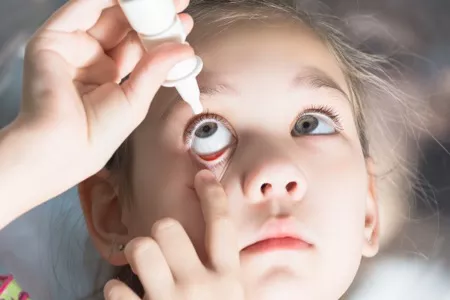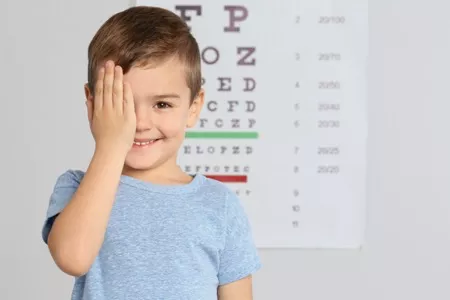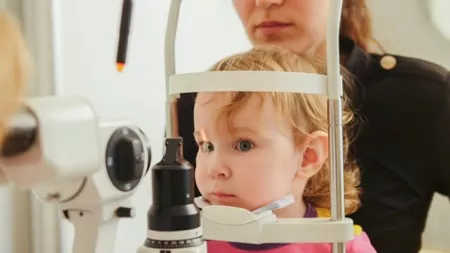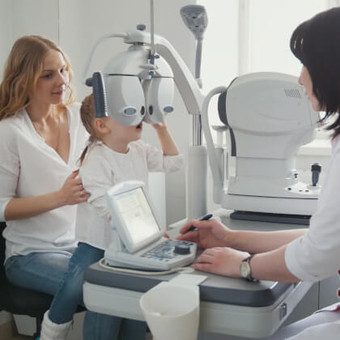Although your child may not be able to tell you precisely what they see, you can be sure that they are taking in the world around them from the moment they are born. Understanding your child's vision development is crucial to ensuring they have the support they need to see clearly and that their eyes are well cared for. Here we'll break down the milestones your child should reach at different ages, signs of vision development issues, common vision problems seen in children, tips to help your child's developing sight, and the importance of annual pediatric vision tests.
- Vision development milestones
- Signs of problems in kids' eyes
- Common kids' eye issues
- How to help your child see better
- Why are pediatric eye exams important?
Vision Development Milestones
Babies begin their vision development from the moment they're born. Like they must learn to walk, talk, and express themselves, kids' eyes must learn how to focus on different objects, move them accurately, and interpret what they are seeing.
During infancy, eye problems can cause developmental delays that a parent may not immediately recognize as a vision issue. It's essential to ensure kids' eyes are evaluated through a thorough eye exam every year to ensure that major milestones are met, and no issues are apparent. General milestones are only a guideline, so it's crucial to see an optometrist each year. Here are the different milestones the American Association of Optometrists and other experts have categorized by age:
- Birth to one month: Between birth and one month of age, a baby should be able to blink in response when exposed to bright lights, stare at objects eight to ten inches away, and begin tracking objects moving in front of them. Babies may appear to have uncoordinated eye movements or be cross-eyed, both normal vision development occurrences. However, if a child's eyes turn in or out consistently, an eye exam is recommended.
- One to two months: At this age, children should be able to focus their eyes on the face of their caregiver or another person within eight to ten inches away. During this stage, babies also begin to develop tears.
- Two to three months: This period is when kids' eyes truly begin to show signs of advancement. They begin to recognize frequently seen objects within a foot, follow objects, faces, and light, and become aware of their own hands.
- Four to five months: Babies around four and five months of age can recognize objects they see frequently, such as a pacifier or a bottle, and should begin to reach for objects they can see. At this age, babies also begin to look at themselves in a mirror.
- Five to seven months: Before this time, babies only see in black and white. Between five and seven months of age, children develop full-color vision, begin to see objects and images from two to three feet away, and can turn their heads to look at objects they're interested in. Babies in this age bracket also begin to prefer certain colors and reach towards their reflection in the mirror.
- Seven to 12 months of age: Around this time, babies begin to develop independent eye control and movement, depth perception, and the ability to see and focus on smaller objects. Kids' eyes can also follow faster-moving objects and recognize objects further away and begin to crawl towards them.
- 12 to 18 months: Beyond their first birthday, kids' eyes begin to advance faster than they have previously. Children can refine their eye movements, recognize familiar objects, and recognize themselves in the mirror. Babies can also crawl or walk to objects that interest them and develop depth perception of items more than two feet away.
- 18 to 24 months: At this age, children have clear vision at a distance, can identify their different body parts, color with crayons, and further develop their fine motor skills.
- Two to three years: Vision development in children between two and three years of age includes an improvement in their depth perception, the ability to focus their eyes and recognize objects and shapes, and the development of binocular vision. Children also typically improve their focusing and convergence vision skills and can change their focus between objects both close up and at a distance.
- Preschool: When a child reaches preschool age, between three and four years, they should be able to identify colors, complex visual shapes, and letters. Their vision development should be near 20/20, and they should continue to develop gross-motor coordination and fine motor skills.
Signs of Vision Development Issues in Kids' Eyes
According to the American Optometric Association, it's rare for infants to have eye and vision development issues. Most babies are born with healthy eyes and develop the visual skills they will need to carry them throughout life with no issues. Although problems are rare, they are possible, and parents and caregivers should be aware of the following issues that could arise:
- Red, irritated, or encrusted eyes or eyelids may be due to eye infections
- Excessive watering could be due to blocked tear ducts
- Extreme light sensitivity may be due to elevated eye pressure
- Frequent eye turning could be due to a problem with eye muscle control
Kids' Eye Infections and Other Issues
The appearance of redness and discharge is typically an indication of an infection, such as pink eye or an infection due to a foreign object's intrusion. Roughly one in eight children will develop an eye infection every year. Eye infections occur when viruses, bacteria, or fungi contaminate the eye or surrounding skin. The most common kids' eye infections are bacterial and viral conjunctivitis, both highly contagious and should be treated immediately. Many kids' eye issues present similarly and making sure you're treating the condition correctly is essential to avoid permanent damage.
How Do I Know if My Kids' Eyes Are Infected?
Thankfully, eye infections are relatively easy to diagnose due to the presence of several symptoms. These signs include:
- Red eyes and eyelids
- Eye pain
- Yellow, green, or bloody discharge
- Sudden blurry vision
- Feeling as though something is in the eye
- Increased light sensitivity
- Crusted eyelids upon waking up
- Fever with no other symptoms
What Causes Eye Infections in Children?
 Children can be exposed to an eye infection at school, daycare, camp, or other group outings or activities that are prime breeding grounds for germs and bacteria. Bacterial conjunctivitis is a highly contagious bacterial eye infection that causes swollen eyelids, green or yellow discharge, the appearance of red or pink eyes, and eyelids that feel stuck together when waking up. Bacterial conjunctivitis can appear in one or both eyes and should immediately be treated by a doctor. Treatment for bacterial conjunctivitis typically includes antibiotic eye drops and isolation from other children and family members, if possible.
Children can be exposed to an eye infection at school, daycare, camp, or other group outings or activities that are prime breeding grounds for germs and bacteria. Bacterial conjunctivitis is a highly contagious bacterial eye infection that causes swollen eyelids, green or yellow discharge, the appearance of red or pink eyes, and eyelids that feel stuck together when waking up. Bacterial conjunctivitis can appear in one or both eyes and should immediately be treated by a doctor. Treatment for bacterial conjunctivitis typically includes antibiotic eye drops and isolation from other children and family members, if possible.
Viral conjunctivitis, also known as pink eye, is almost a rite of passage in childhood. This highly contagious infection is caused by a virus and typically impacts both eyes. If your child complains of itchy eyes or you notice their eyes are pink with excessive tearing, a call to the doctor is in order. Pink eye can also present itself with a sore throat, fever, and runny nose. Treatment for pink eye includes isolation from others to avoid spreading the infection, ice packs, and over-the-counter eye drops. Once the eye-watering stops, your child is no longer contagious. The infection typically lasts between three to seven days and can usually be treated at home.
Blocked Tear Ducts in Kids' Eyes
Although blocked tear ducts may sound scary, this condition is common and will usually resolve itself without treatment. A blocked tear duct occurs when something obstructs the tear duct’s opening, preventing tears from draining correctly. Roughly ten percent of babies are born with a blocked tear duct, which a doctor can diagnose by the presence of irritated and watery eyes and continuous watering that looks like tears.
Blocked tear ducts are usually nothing to worry about, but the condition can cause a secondary eye infection. If you notice swelling, redness, and discharge from your child's eye, contact your pediatrician.
What Is Pediatric Glaucoma?
Pediatric glaucoma is similar to the disease in adults that can cause irreparable damage to a child's eyesight. Glaucoma is complicated and includes issues such as visual field loss and damage to the optic nerve. In pediatric glaucoma, the child's age determines the classification of the condition.
Congenital glaucoma is present when a child is born, infantile glaucoma appears in children between ages one to two years, and juvenile glaucoma occurs in children age three and older. Although the disease itself is similar, children and adults present different symptoms concerning glaucoma. In infantile and congenital glaucoma, caregivers may notice light sensitivity, excessive watering of the eyes, and a cloudy cornea or dull-looking iris. Juveniles typically present symptoms that mimic those of adults, including elevated eye pressure and cupping of the optic nerve. Juvenile glaucoma is typically hereditary. Families with a history of the condition should take additional precautions to ensure their kids' eyes and vision development are monitored through frequent eye exams.
Problems with Kids' Eye Muscle Control
At birth, infants cannot control their eyes independently of one another, which may appear as wandering eyes or crossed eyes. Although this lack of eye muscle control is normal, children who continue to show symptoms of eye muscle control issues should be evaluated by a professional.
Strabismus is the medical condition in which the eyes don't line up correctly, or one or both eyes seem to wander. The eyes can turn up, down, inward, or outward. When kids' eyes don't line up correctly, the straighter eye can become more dominant, preventing the other eye from focusing correctly and impacting the connection between eyesight and the brain.
Most children with strabismus are formally diagnosed between one and four years old, although the condition may be present at birth or develop during their first few years. If a doctor or parent catches the condition quickly and begins treatment, the child is typically able to regain full use of their vision. If left alone, the brain can begin to ignore the signals it receives from the weaker eye, causing double or blurry vision and issues with depth perception.
Parents, caregivers, teachers, or pediatricians are typically the reason a child is diagnosed with strabismus because the child either doesn't comment on changes in their eyesight or is not old enough to vocalize the vision development issues they're experiencing. If you notice your child's eyes appear out of alignment or they're squinting or tilting their head to see, contact your health care provider for a referral to a pediatric ophthalmologist.
How to Improve Children's Eyesight and Vision Development
As a parent or caregiver, it's natural to want to do everything in your power to help your child grow and develop with as few challenges as possible. While a child's vision development may seem predetermined, there are many things you can do to give your child the best foundation possible for good vision.
- Birth to four months: During their early months, parents and caregivers can nurture kids' eyes in several ways. Add a nightlight or a small lamp to their nursery, talk to them while holding them so they can place where your voice is coming from, and alternate their positioning during feedings, so they see you from different angles. Experts also recommend changing the crib position within the room and changing the child's position in the crib. During playtime, keep toys that babies can touch and feel within their vision depth, roughly eight to twelve inches away.
- Five to eight months: Between five to eight months of age, you can help your kid’s eyes develop by providing blocks or other items they can hold and observe, using a mobile or infant gym to provide objects that they can grab, kick, and pull, and allowing plenty of floor time to explore their surroundings.
- Nine to 12 months: As your child approaches their first birthday, encourage their visual development and memory skills by playing hide and seek with toys or other objects. You should continue word association and vocabulary by naming objects during playtime and throughout the day and encourage crawling and exploring.
- One to two years: Continue to encourage your children's eyesight by working to help them track objects with their eyes as they play. Roll a ball back and forth, hold up items, bring them close to the child's hands, and play with building blocks. Stimulating your child's vocabulary is also crucial throughout childhood. Tell stories, read, and narrate your day so your baby can learn to visualize and prepare for learning to read.
The Importance of Children's Eye Exams
 Protecting eyesight during infancy is crucial to ensuring your child has the proper vision development as they grow. Optometrists recommend children have an eye exam beginning at six months of age to diagnose any issues, ensure their children's eyesight is developing correctly, and discuss any concerns you may have.
Protecting eyesight during infancy is crucial to ensuring your child has the proper vision development as they grow. Optometrists recommend children have an eye exam beginning at six months of age to diagnose any issues, ensure their children's eyesight is developing correctly, and discuss any concerns you may have.
Children's eyesight can have a dramatic impact on their education as they grow up and begin school. If a child isn't able to see clearly, they may have trouble completing assignments or participating in class, exhibit behavior issues out of frustration, or complain of headaches during the day. According to the American Optometric Association, one in four school-aged children suffer from undiagnosed vision issues that dramatically influence their visual perception capabilities.
What Happens During a Children's Vision Test?
During a child's first eye exam, the doctor will ask questions about their birth, family history, and medical history. These questions can include any complications the mother experienced during delivery or pregnancy, whether the child was born full-term, and their weight at birth.
 At six months of age, a children's vision test includes assessments for color vision, eye focusing, and depth perception. These tests include examining their pupil responses when exposed to light, preferential looking using specially designed cards, and how they can focus on and track an object as it moves.
At six months of age, a children's vision test includes assessments for color vision, eye focusing, and depth perception. These tests include examining their pupil responses when exposed to light, preferential looking using specially designed cards, and how they can focus on and track an object as it moves.
As they prepare for preschool, children's eyesight should continue to evolve, and the vision tests your eye doctor conducts will reflect this. A comprehensive children's eyesight exam will typically involve tests for:
- Ocular health
- Eye-tracking
- Color vision
- Visual acuity
- Lazy eyes
- Stereopsis or 3D vision
- Convergence
Protecting eyesight in children requires paying close attention to the changes and visual developments during their formative years. Be sure to contact your eye care provider with any questions you have to help ensure you're protecting your children's eyesight for their future.
Subscribe to our Newsletters

 Save yourself from getting into rush hours and buy your contacts online.
Save yourself from getting into rush hours and buy your contacts online.








